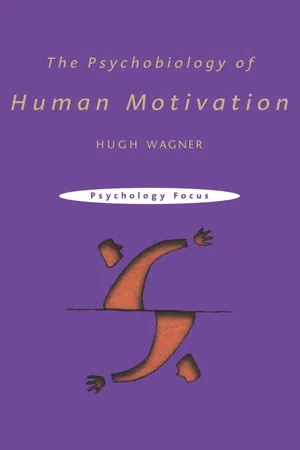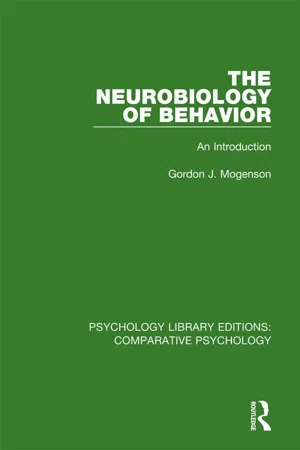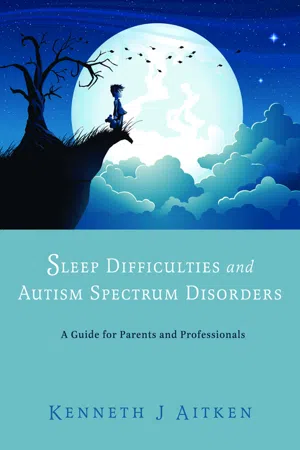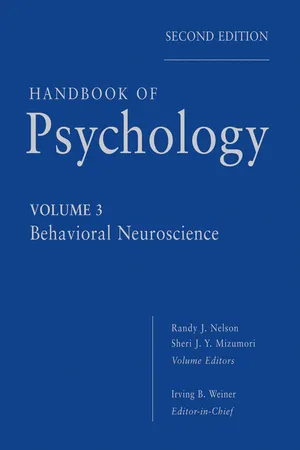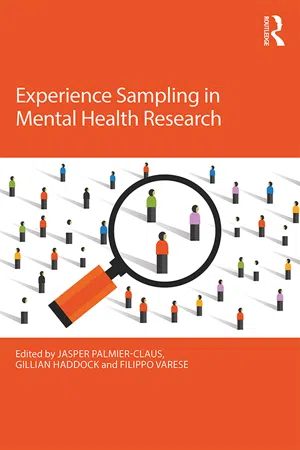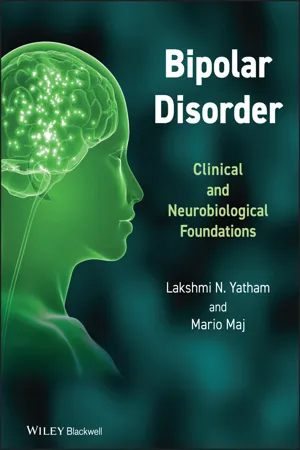Psychology
Sleep Wake Cycle
The sleep-wake cycle, also known as the circadian rhythm, refers to the natural pattern of sleep and wakefulness that repeats roughly every 24 hours. It is regulated by the body's internal clock and influenced by external factors such as light and temperature. Disruptions to the sleep-wake cycle can lead to sleep disorders and impact overall health and well-being.
Written by Perlego with AI-assistance
Related key terms
6 Key excerpts on "Sleep Wake Cycle"
- eBook - ePub
- Hugh Wagner(Author)
- 2014(Publication Date)
- Routledge(Publisher)
Chapter 3Biological rhythms and sleep■ Circadian rhythmsJet-lag and shift-work■ Other biological rhythms■ Mechanisms of biological rhythms■ The nature of sleepElectroencephalography Rapid eye-movement sleep Sleep across species Development of sleep■ Sleep deprivation■ Dreaming■ Mechanisms of sleep■ Functions of sleep■ Summary■ Further readingLIFE is DOMINATED BY a daily drive to fall asleep. Such rhyth-micity is characteristic of animal and even plant activity. While the daily cycle of sleeping and waking is the most obvious rhythm for us, there are others, as we shall see. The importance to psychology of such rhythms is that they involve variations in motivated behaviour, emotional state and cognitive performance. For psychobiology the questions are, for example, what are the origins of these cycles? Are they driven by an internal clock? How are they influenced by external events? What are their implications for daily life? What happens if they go wrong or if we disturb them? Why do we spend about one third of our lives asleep?Circadian rhythms
The daily sleep-waking rhythm is known as a circadian rhythm (meaning ‘about daily’). Humans (and most other primates) are diurnal (meaning active in daylight), while many other animals (e.g. rodents) are nocturnal. The circadian rhythm is most obvious to us as a daily alternation of sleeping and waking. But it is much more than that: underlying the sleep-waking cycle are continuous - eBook - ePub
The Neurobiology of Behavior
An Introduction
- Gordon J. Mogenson(Author)
- 2018(Publication Date)
- Routledge(Publisher)
Figure 3.9 ; heart rate; the release of certain hormones) change in a circadian manner in relation to the circadian rhythm of sleep and waking. When the normal cycle of such rhythms is suddenly changed, as for a “shift worker’’ who switches from the 8:00 a.m. to the 12:00 p.m. shift or the jet traveller who flys halfway around the world, bodily functions are disrupted, and the person may not “feel right,” not only because of lack of sleep initially, but also because it may take several days for these rhythms to become synchronized to the new sleep-waking cycle determined by the day-night sequence.Little is known about the mechanisms that control the sleep-waking cycle and the circadian rhythms of various physiological parameters. The importance of “biological clocks” has only recently been recognized, and empirical evidence is limited (Rusak & Zucker, 1975). Speculations about the biological significance of the sleep-waking cycle, which might give some clues about underlying mechanisms, depend largely on whether one considers sleep as having a restorative function or considers it from the ethological point of view. If sleep is involved in “metabolic recovery” or has a restorative function, then the cyclic nature of sleep might be the result of the waxing and waning of some metabolic or homeostatic signals (e.g., a toxin according to classical theories); support for this hypothesis, as indicated previously, is lacking. Alternatively, it has been suggested from the ethological point of view that the function of sleep is to conserve energy during certain periods of the day so that the animal can be active during periods advantageous to its survival (Rusak & Zucker, 1975; and see p. 10 and p. 97).FIG. 7.7 Running activity of a rat before and after blinding. Note that the circadian cycle of activity and rest continues after blinding, but there is a phase shift. (From Richter, 1965.)Emotional and Cognitive FactorsThe ease of falling asleep, as well as the maintenance and the duration of sleep, are influenced by the emotional state of the subject. As more and more people live in the cities and participate in complex and competitive industrialized societies, the incidence of sleep disorders has increased. Sleep clinics have been established to deal with these problems, and a new profession of “sleep specialists” has emerged (Kales et al., 1974). Sleep disturbance includes narcolepsy, sleep apnea, somnambulism, nightmares, sleep walking, and enuresis, but the most frequent complaint is insomnia. - eBook - ePub
Sleep Difficulties and Autism Spectrum Disorders
A Guide for Parents and Professionals
- Kenneth Aitken(Author)
- 2012(Publication Date)
- Jessica Kingsley Publishers(Publisher)
The similarities in the underpinning biological processes, across the animal kingdom, are allowing significant developments in our understanding of human sleep to be made through the study of its development in other ‘model organisms’ such as Drosophila melanogaster (the fruit fly) and Danio rerio (the zebrafish) (Hendricks, Sehgal and Pack 2000). In addition to sleep–wake cycle issues, mood disorders including unipolar depression and seasonal affective disorder are typically due to abnormalities of the circadian system (McClung 2007; Monteleone and Maj 2008). There is a growing body of evidence that circadian abnormalities are seen in a large proportion of individuals with ASDs (Glickman 2010). Methods for the reliable assessment of human circadian rhythms are now available and in use (see Hofstra and de Weerd 2008). Variations in cognitive ability follow a circadian pattern and are affected both by endogenous circadian clocks and external factors that vary the amount and timing of actual sleep (Kyriacou and Hastings 2010). W HAT IS SLEEP? A useful starting point in understanding and unravelling sleep problems is trying to get a basic idea of what sleep is, why we might do it and what it might be for. We should start by defining what we mean by sleep. There are many definitions to choose from. Here is a selection: Sleep is a reversible condition of reduced responsiveness usually associated with immobility. (Cirelli and Tononi 2008, p.1605) …sleep is that golden chain that ties health and our bodies together. (Thomas Dekker, The Gull’s Hornbook 1609) Sleep is the interest we have to pay on the capital which is called in at death; and the higher the rate of interest and the more regularly it is paid, the further the date of redemption is postponed. (Arthur Schopenhauer) Sleep that knits up the ravelled sleave of care, the death of each day’s life, sore labour’s bath, balm of hurt minds, great nature’s second course, chief nourisher in life’s feast - eBook - ePub
- Irving B. Weiner, Randy J. Nelson, Sheri Mizumori(Authors)
- 2012(Publication Date)
- Wiley(Publisher)
While all other relevant masking factors are held constant, sleep-wake cycles are scheduled to be either too long (28 hours) or too short (20 hours) to permit entrainment of the endogenous oscillator; under such conditions, the SCN oscillator free-runs with a period of approximately 24 hours, and the effects of the sleep-wake cycle on a given rhythm can be observed at all circadian phases. In the following section we highlight the distinct and combined influences of the sleep-wake cycle and the endogenous circadian clock on the expression of several biological rhythms—both behavioral and physiological—studied under conditions of constant routine and forced desynchrony. Normal Behavioral and Physiological Processes Modulated by Circadian Rhythmicity and Sleep-Wake Homeostasis: Performance, Mood, and Physiology Nathaniel Kleitman, a pioneer in sleep and circadian research, first made the systematic link between cognitive performance, chronobiology, and sleep in 1933 by noting a diurnal variation in speed and accuracy of cognitive performance. On a number of neurobehavioral tasks, he observed a consistent pattern of best performance in the afternoon and worst performance in the early in the morning, just after waking, and in the late evening, just before sleep (Kleitman, 1933). He also noted that this temporal variation in performance was directly related to the diurnal rhythm in body temperature. Since the concept of an endogenous circadian rhythm had not been considered in 1933, Kleitman assumed that by heating up the body, one could improve the speed and accuracy of brain function. Since that time, a number of studies have used constant routine protocols in an attempt to delineate the endogenous temporal variation of objective alertness and neurobehavioral performance - eBook - ePub
- Jasper Palmier-Claus, Gillian Haddock, Filippo Varese(Authors)
- 2019(Publication Date)
- Routledge(Publisher)
6Experience sampling in the study of sleep and wakefulness
Lee Mulligan, Gillian Haddock, Donna Littlewood and Simon D. KyleWhat is sleep?
Sleep is a complex, universal behaviour described as “a reversible state of perceptual disengagement from, and unresponsiveness to, the environment” (Carskadon & Dement, 2011). Although the exact function of sleep remains elusive, it is fundamental for human health and wellbeing and necessary for the repair of numerous biological, psychological, emotional and cognitive processes (Colrain, 2011).Two interacting processes govern sleep, which together regulate sleep and wakefulness. One process is the homeostatic drive for sleep, or “sleep pressure” (Borbély, 1982). In essence, sleep pressure begins at the onset of wakefulness and increases throughout the day, until the next onset of sleep. The other is the circadian system; our internal body clocks are synchronised to the earth’s solar period (roughly 24 hours), which is regulated through exposure to day and night (Czeisler et al., 1999). This system facilitates the onset of sleep and wakefulness through the regulation of body temperature and production of sleep promoting hormones (i.e. melatonin).Sleep and ESM
Given the interdependence of sleep and wake regulation, time-sampling research affords the opportunity to probe relationships between sleep processes and mechanisms known to contribute to mental health difficulties. Indeed, accumulating sleep pressure may affect several cognitive and attentional processes (Van Dongen & Dinges, 2005). Furthermore, there is a wealth of causal evidence that experimental sleep and circadian disruption engenders symptom change in a variety of populations (Pilcher & Huffcutt, 1996; Dinges et al., 1997; Petrovsky et al., 2014) and conversely, stress induction predicts subsequent sleep disturbance (Hall et al., 2007). Therefore, mapping the dynamic bi-directionality between sleep and psychiatric symptoms over time holds significant promise in advancing our understanding of transdiagnostic processes underlying mental health problems (Harvey, Murray, Chandler & Soehner, 2011). - eBook - ePub
Bipolar Disorder
Clinical and Neurobiological Foundations
- Lakshmi N. Yatham, Mario Maj(Authors)
- 2011(Publication Date)
- Wiley(Publisher)
non-photic cues, including arousal/locomotor activity, social cues, feeding, sleep deprivation and temperature [12].SleepPhylogenetically, sleep is a more recent and less ubiquitous adaptation than circadian rhythmicity [13]. The specific adaptive function of sleep is unknown, but the fact that sleep is strongly conserved in mammals [14], and evidence for marked physical and cognitive consequences of sleep deprivation in humans (e.g. [15]), suggest that sleep serves an important function. Evidence is also accumulating for sleep’s role in particular types of cognition [16], memory consolidation and brain plasticity [17–19,21].Based on characteristic physiological patterns, normal sleep can be divided into two distinct states: rapid eye movement (REM) and non-rapid eye movement (NREM). During REM (or paradoxical) sleep, the brain is highly activated, the muscles of the body are paralysed and dreaming occurs. In NREM, growth hormone is preferentially secreted and protein synthesis is increased, leading to the view that NREM may be critical for energy conservation and restoration. Characteristic EEG patterns support NREM sleep being further categorized into substages: (1) drowsiness, transition to sleep, lowest arousal thresholds; (2) light sleep; (3) and (4) deep sleep, highest arousal thresholds. Together, (3) and (4) are often called delta or slow wave sleep (SWS) [22].On a typical night, sleep of a young adult begins in Stage (1) NREM and progresses through deeper NREM stages. The first episode of REM sleep occurs approximately 80–100 minutes after sleep onset. Thereafter, NREM sleep and REM sleep cycle with a period of approximately 90 minutes. NREM stages (3) and (4) concentrate in the early cycles and REM sleep episodes lengthen across the night. Therefore, in a normal night of sleep, SWS predominates in the early part of the sleep phase, while REM is more prevalent later in the night. Indeed, we are most likely to wake through the gate of REM sleep.
Learn about this page
Index pages curate the most relevant extracts from our library of academic textbooks. They’ve been created using an in-house natural language model (NLM), each adding context and meaning to key research topics.
